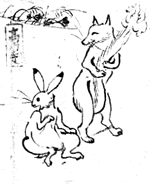Choju-Giga

Choju-Giga (Choju-Jinbutu-Giga, [Frolicking Animals and People]) consists of four volumes of satirical drawings that have belonged to Kozanji Monastery, Kyoto, since the 12th and 13th centuries. The true artist, or artists remain unknown, but Toba Sojo (1053-1140), who is also known as Kakuyu, is credited with being a main source of the first two scrolls because a painting carrying his name that is similar to this work remains even today. But no existing indisputable evidence supports this belief. The first of the four works is the most famous and is also the longest, 11 meters (36 ft), and it is 30 cm (1 ft) wide. Some of it is shown as the scrolling graphic head of this home page.
In 1965, the 23rd meeting of the IUPS (International Union of Physiological Sciences) was held in Tokyo, and a replica of Choju-Giga was attached to the souvenir bag presented to all attendees as a remembrance of the event. The PSJ's Journal of Physiological Sciences has for many years (since vol 29 [11]: p627, 1967) been using various small parts of Choju-Giga as pictorial material. The ancient work inspired the editor back then to express how many physiologists enjoy their lives in the various fields of physiology.
 In his famous book, Japan: A Short Cultural History, G. B. Sansom said, “The work belongs to the decline of the Fujiwara period, but it expresses in one of its best aspects the artistic spirit of their age. The artist is a delightful draughtsman. His pictures of animals disporting [themselves] in the garb of monks are alive with satirical fun. They are a true fruit of the native wit; they owe nothing to China beyond a vague debt to her older artistic tradition; and they bear witness to that reaction against the solemnities of Buddhist art which we have noticed.”
In his famous book, Japan: A Short Cultural History, G. B. Sansom said, “The work belongs to the decline of the Fujiwara period, but it expresses in one of its best aspects the artistic spirit of their age. The artist is a delightful draughtsman. His pictures of animals disporting [themselves] in the garb of monks are alive with satirical fun. They are a true fruit of the native wit; they owe nothing to China beyond a vague debt to her older artistic tradition; and they bear witness to that reaction against the solemnities of Buddhist art which we have noticed.”
Viewers should observe the scroll from right to the left. The method of viewing is related to the way of reading “manga,” Japanese cartoons. Choju-Giga is often credited as being the oldest works of manga in Japan, and many Japanese animation creators believe that it is the origin of animated movies.
The four scrolls, considered National Treasures, are now strictly stored safeguarded and cared for. The first two are currently displayed at the Tokyo National Museum, and the second two at the Kyoto National Museum. Reproductions are on public display at Kozan-ji, Togano-o, in Kyoto.
